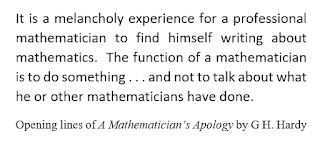A posting early this month featured the noted Indian mathematician Ramanujan (1887-1920) who was mentored by the British mathematician G. H. Hardy (1877-1947). In addition to his important achievements in number theory and mathematical analysis, Hardy is well-known for his book, A Mathematician's Apology (Cambridge Univ. Press, 1969). Here are its opening lines:
A diamond's beauty
depends on reflection
of outside light.






